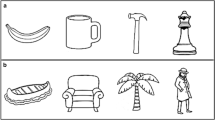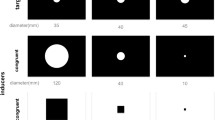Abstract
Previous studies have reported that the visual form agnosic D.F. is able to use information about visual targets for the control of motor acts, but has great difficulty in using the same visual information for perceptual report. This intact visuomotor performance may be mediated by relatively intact parieto-frontal cortical mechanisms. The present study investigated the ability of D.F. to use binocular and monocular information about the orientation of an object in the depth plane for perceptual and visuomotor purposes. A square plaque was presented at seven different orientations in depth to D.F. and to three age- and sex-matched control subjects. Subjects were required to reach out and grasp the plaque using a precision grip (index finger and thumb) under binocular and monocular viewing conditions, and in separate trials to match the orientation of a hand-held plaque to the perceived orientation of the target object, also under both binocular and monocular conditions. D.F.'s performance in grasping trials was found to be normal under binocular conditions, but was substantially worsened by removal of binocular vision. She was severely impaired at matching the orientation of the test square, although under binocular conditions her performance rose clearly above chance. The data suggest that the separation of cortical processing for visuomotor and visual perceptual purposes also applies, at least in part, to information about the orientation in depth of an object. The impaired performance under monocular viewing conditions on the visuomotor task is in agreement with recent physiological data and suggests that posterior parietal systems depend critically on binocular input for the processing of orientation in depth when ventral-stream information is unavailable.
Similar content being viewed by others
References
Baizer JS, Ungerleider LG, Desimone R (1991) Organization of visual inputs to the inferior temporal and posterior parietal cortex in macaques. J Neurosci 11: 168–190
Benton AL, Hamsher KSD, Varney NR, Spreen O (1983) Contributions to neuropsychological assessment. Oxford University Press, New York
Carey DP, Harvey M, Milner AD (1996) Visuomotor sensitivity for shape and orientation in a patient with visual form agnosia. Neuropsychologia 34: 329–337
Cowey A (1994) Cortical visual areas and the neurobiology of higher visual processes. In: Farah MJ, Ratcliff G (eds) The neuropsychology of high-level vision. Erlbaum, Hillsdale, NJ
Dijkerman HC, Milner AW (1996) Copying without perceiving: motor imagery in visual forum agnosia. Neuro Report (in press)
Felleman DJ, Van Essen DC (1987) Receptive field properties of neurons in area V3 of macaque monkey extrastriate cortex. J Neurophysiol 57: 889–920
Felleman DJ, Van Essen DC (1991) Distributed hierarchical processing in the primate cerebral cortex. Cereb Cortex 1: 1–47
Gentilucci M, Daprati E, Gangitano M, Saetti MC, Toni I (1996) Orienting the hand to reach and grasp an object. Neuroreport 7: 589–592
Goodale MA, Milner AD, Jakobson LS, Carey DP (1991) A neurological dissociation between perceiving objects and grasping them. Nature 349: 154–156
Goodale MA, Meenan JP, Bülthoff HH, Nicolle DA, Murphy KJ, Racicot CI (1994) Separate neural pathways for the visual analysis of object shape in perception and prehension. Curr Biol 4: 604–610
Grafton ST, Fagg AH, Woods RP, Arbib MA (1996) Functional anatomy of pointing and grasping in humans. Cereb Cortex 6: 226–237
Gulyás B, Roland PE (1994) Processing and analysis of form, colour and binocular disparity in the human brain: functional anatomy by positron emission tomography. Eur J Neurosci 6: 1811–1828
Haggard P, Wing AM (1990) Assessing and reporting the accuracy of position measurements made with optical tracking systems. J Mot Behav 22: 315–321
Jeannerod M, Rossetti Y (1993) Visuomotor coordination as a dissociable visual function: experimental and clinical evidence. In: Kennard C (ed) Visual perceptual defects (Baillière's clinical neurology, vol 2, no. 2). Baillière Tindall, London
Jeannerod M, Arbib MA, Rizzolatti G, Sakata H (1995) Grasping objects: the cortical mechanisms of visuomotor transformation. Trends Neurosci 18: 314–320
Julesz B (1971) Foundations of cyclopean perception. University of Chicago Press, Chicago
Kusunoki M, Tanaka H, Ohtsuka K, Ishiyama K, Sakata H (1993) Selectivity of the parietal visual neurons in the axis orientation of objects in space. Soc Neurosci Abstr 19: 770
Mamassian P, Bülthoff H, Kersten D (1995) Eye-hand coordination for 3-D oriented objects. Technical report 12, Max Planck Institute, Tübingen, Germany
Milner AD, Goodale MA (1993) Visual pathways to perception and action. In: Hicks TP, Molotchnikoff S, Ono T (eds) Prog Brain Res 95: 317–337
Milner AD, Goodale MA (1995) The visual brain in action. Oxford University Press, Oxford
Milner AD, Heywood CA (1989) A disorder of lightness discrimination in a case of visual form agnosia. Cortex 25: 489–494
Milner AD, Perrett DI, Johnston RS, Benson PJ, Jordan TR, Heeley DW, Bettucci D, Mortara F, Mutani R, Terazzi E, Davidson DLW (1991) Perception and action in ‘visual form agnosia’. Brain 114: 405–428
Morel A, Bullier J (1990) Anatomical segregation of two cortical visual pathways in the macaque monkey. Vis Neurosci 4: 555–578
Oldfield RC (1971) The assessment and analysis of handedness: the Edinburgh inventory. Neuropsychologia 9: 97–114
Ptito A, Zatorre RJ, Petrides M, Frey S, Alivisatos B, Evans AC (1993) Localization and lateralization of stereoscopic processing in the human brain. Neuroreport 4: 1155–1158
Reinhardt-Rutland AH (1992) Primary depth cues and background pattern in the portrayal of slant. J Gen Psychol 119: 29–35
Reinhardt-Rutland AH (1996) Perceiving the orientation-in-depth of triangular surfaces: static-monocular, moving-monocular and static-binocular viewing. J Gen Psychol 123: 19–28
Sakata H, Taira M, Murata A, Gallese V, Tanaka Y, Shikata E, Ku-sunoki M (in press). Parietal visual neurons coding 3-D characteristics of objects and their relation to hand action. In: Thier P, Karnath H-O (eds) Parietal lobe contributions to orientation in 3-D space. Springer, Berlin Heidelberg New York
Servos P, Martin L, Goodale MA (1995) Dissociation between two modes of spatial processing by a visual form agnosic. Neuroreport 6: 1893–1896
Snodgrass JG, Vanderwart M (1980) A standardized set of 260 pictures: norms for name agreement, image agreement, familiarity and visual complexity. J Exp Psychol [Hum Learn Mem] 6: 174–215
Turnbull OH, Laws KR, McCarthy RA (1995) Object recognition without knowledge of object orientation. Cortex 31: 387–395
Ungerleider LG, Mishkin M (1982) Two cortical visual systems. In: Ingle DJ, Goodale MA, Mansfield RJW (eds) Analysis of visual behavior. MIT Press, Cambridge, Mass
Young MP (1992) Objective analysis of the topological organization of the primate cortical visual system. Nature 358: 152–155
Author information
Authors and Affiliations
Rights and permissions
About this article
Cite this article
Dijkerman, H.C., Milner, A.D. & Carey, D.P. The perception and prehension of objects oriented in the depth plane. Exp Brain Res 112, 442–451 (1996). https://doi.org/10.1007/BF00227950
Received:
Accepted:
Issue Date:
DOI: https://doi.org/10.1007/BF00227950




